HISTORY
The existence of urbanized settlements in the area that is now Dhaka dates from the 7th century. The city area was ruled by the Buddhist kingdom of Kamarupa and the Pala Empire before passing to the control of the Hindu Sena dynasty in the 9th century.
 |
The name of the city may have derived after the establishment of the Goddess Dhakeshwari's temple by Ballal Sena in the 12th century.Dhaka and its surrounding area was identified as Bengalla around that period. The town itself consisted of a few market centers like Lakshmi Bazar, Shankhari Bazar, Tanti Bazar, Patuatuli, Kumartuli, Bania Nagar and Goal Nagar. After the Sena dynasty, Dhaka was successively ruled by the Turkic and Pashtun governors descending from the Delhi Sultanate before the arrival of the Mughals in 1608.
GEOGRAPHY
Dhaka is located in central Bangladesh on the eastern banks of the Buriganga River.
 |
The city lies on the lower reaches of the Ganges Delta and covers a total area of 153.84 square kilometres (59.40 sq mile.It consists of eight principal thanas, Lalbagh, Kotwali,Sutrapur, Ramna, Motijheel, Paltan, Dhanmondi, Mohammadpur, Tejgaon, and 16 auxiliary thanas Gulshan, Mirpur, Pallabi, Shah Ali, Turaag, Sabujbagh, Dhaka Cantonment, Demra, Hazaribagh, Shyampur, Badda, Kafrul, Kamrangir char, Khilgaon and Uttara. In total the city has 130 wards and 725 mohallas. Dhaka district has an area of 1463.60 square kilometres (565 sq mi); and is bounded by the districts of Gazipur, Tangail, Munshiganj, Rajbari, Narayanganj, Manikganj. Tropical vegetation and moist soils characterise the land, which is flat and close to sea level. This leaves Dhaka susceptible to flooding during the monsoon seasons owing to heavy rainfall and cyclones.
CLIMATE
Dhaka experiences a hot, wet and humid tropical climate. Under the Koppen climate classification, Dhaka has a tropical wet and dry climate.
 |
The city has a distinct monsoonal season, with an annual average temperature of 25 deg C (77 deg F) and monthly means varying between 18 deg C (64 deg F) in January and 29 deg C (84 deg F) in August. Nearly 80% of the annual average rainfall of 1,854 millimeters (73 in) occurs between May and September. Increasing air and water pollution emanating from traffic congestion and industrial waste are serious problems affecting public health and the quality of life in the city. Water bodies and wetlands around Dhaka are facing extinction as these are being filled up to construct multi-storied buildings and other real estate developments. Coupled with pollution, such erosion of natural habitats threatens to destroy much of the regional biodiversity.
CIVIL ADMINISTRATION
The Dhaka municipality was founded on August 1, 1864 and upgraded to "corporation" status in 1978. The Dhaka City Corporation is a self-governing corporation which runs the affairs of the city. The incorporated area is divided into several wards, which have elected commissioners. The mayor of the city is elected by popular vote every five years, and the post is presently held by Sadeque Hossain Khoka.
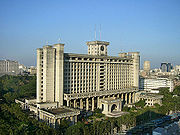 |
The Dhaka Education Board is responsible for administering all public schools and most private schools with the exception of English-medium schools and madrassahs.. All madrassahs in Bangladesh are governed by a central board while English-medium schools are under separate educational and governance structures.
 |
The Dhaka Metropolitan Police (DMP) was established in 1976 and has 6,000 personnel in 12 police stations. With the rapid population growth of the city, the force has been raised to 23,000 personnel and the establishment of 33 police stations has been completed and the creation of another 18 police stations is underway.
ECONOMY
Dhaka is the commercial heart of Bangladesh. The city has a growing middle class population, driving the market for modern consumer and luxury goods. The city has historically attracted a large number of migrant workers. Hawkers, peddlers, small shops, rickshaw transport, roadside vendors and stalls employ a large segment of the population rickshaw-drivers alone number as many as 400,000.
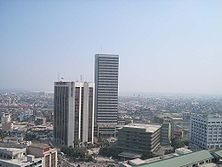 |
Half the workforce is employed in household and unorganised labour, while about 800,000 work in the textile industry. Even so, unemployment remains high at 23%. As of 2008, Dhaka's Gross Municipal Product (GMP) is registered at $78 billion. With an annual growth rate of 6.2%, the GMP is projected to rise to $215 billion by 2025.
 |
The annual per capita income of Dhaka is estimated at $500, with 48% of households living below the poverty line, including a large segment of the population coming from the villages in search of employment, with many surviving on less than $10 a day. The main commercial areas of the city include Farmgate, New Market, Gulshan and Motijheel, while Tejgaon and Hazaribagh are the major industrial areas.
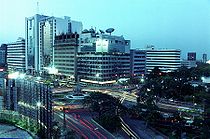 |
Bashundhara-Baridhara is a developing economic area that will include high-tech industries, corporations and a large shopping mall in about 5 years. The Export Processing Zone in Dhaka was set up to encourage the export of garments, textiles and other goods. Dhaka has two EPZ's. They are home to 413 industries, which employ mostly women.
CULTURE
As the most populous city of Bangladesh, Dhaka has a vibrant cultural life. Annual celebrations for Independence Day (March 26), Language Martyrs' Day (February 21) and Victory Day (December 16) are prominently celebrated across the city. Dhaka's people congregate at the Shaheed Minar and the Jatiyo Smriti Soudho to remember the national heroes of the liberation war.
 |
These occasions are observed with public ceremonies and rallies in public grounds. Many schools and colleges organize fairs, festivals and concerts in which citizens from all levels of society participate. Pohela Baishakh, the Bengali New Year, falls annually on April 14 and is popularly celebrated across the city.
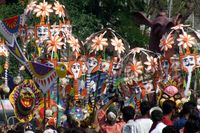 |
Large crowds of people gather on the streets of Shahbag, Ramna Park and the campus of the University of Dhaka for celebrations. The most popular dressing style for women are sarees or salwar kameez, while men usually prefer western clothing to the traditional lungi. The Muslim festivals of Eid ul-Fitr ,Eid ul-Adha & Hindu festival Durga Puja witnesses widespread celebrations across the city.
TRANSPORT
Cycle rickshaws and auto rickshaws are the main mode of transport, with close to 400,000 rickshaws running each day – the largest number for any city in the world. However, only about 85,000 rickshaws are licensed by the city government.
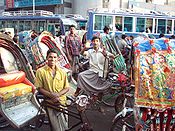 |
Relatively low-cost and non-polluting cycle rickshaws nevertheless cause traffic congestion and have been banned from many parts of the city. Public buses are operated by the state-run Bangladesh Road Transport Corporation (BRTC) and by private companies and operators. Scooters, taxis and privately owned automobiles are increasingly becoming popular with the city's growing middle class. The government has overseen the replacement of two-stroke engine taxis with "Green taxis" locally called CNG, which run on compressed natural gas.
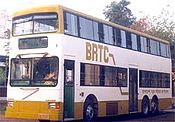 |
Dhaka has 1,868 kilometers (1,161 mi) of paved roads. It is connected to the other parts of the country through strong highway and railway links. Highway links to the Indian cities of Kolkata and Agartala have been established by the BRTC which also runs regular bus services to those cities from Dhaka.
EDUCATION
Dhaka has the largest number of schools, colleges and universities of any Bangladeshi city. The education system is divided into 4 levels: Primary (from grades 1 to 5), Secondary (from grades 6 to 10), Higher Secondary (from grades 11 to 12) and tertiary. The five years of lower secondary education concludes with a Secondary School Certificate (SSC) Examination. Students who pass this examination proceed to two years of Higher Secondary or intermediate training, which culminate in a Higher Secondary Certificate (HSC) Examination. Education is mainly offered in Bangla, but English is also commonly taught and used.
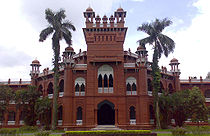 |
A large number of Muslim families send their children to attend part-time courses or even to pursue full-time religious education, which is imparted in Bangla and Arabic in madrasahs. There are 52 universities in Dhaka. The Dhaka College is the oldest institution of higher education in the city and amongst the earliest established in British India, founded in 1840. Since independence, Dhaka has seen the establishment of a large number of public and private colleges and universities that offer undergraduate and graduate degrees as well as a variety of doctoral programs. The best Engineering university of this country Bangladesh University of Engineering and Technology (BUET).
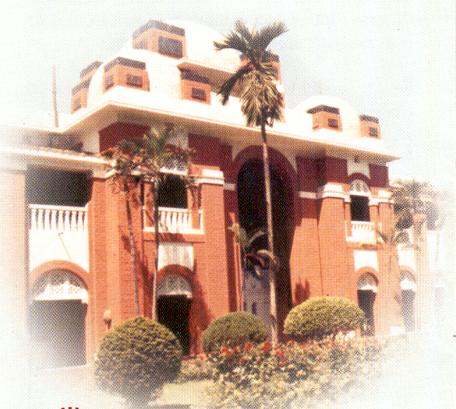 |
The University of Dhaka is the largest public university in the nation with more than 30,000 students and 1,300 faculty staff. The university has 18 research centers and 70 departments, faculties and institutes. Eminent seats of higher education include the Jahangirnagar University . The Dhaka Medical College and the Sir Salimullah Medical College are amongst the largest and most respected medical schools in the nation.
 |
Dhaka's college campuses are often hotbeds of political conflicts. Protests and strikes, and violence amongst police, students and political groups frequently disrupt public university campuses.
